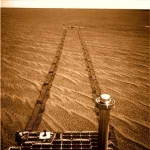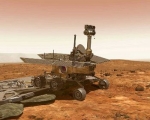Displaying items by tag: Spirit (rover)
Mars Exploration Rovers (MER)
NASA's Mars Exploration Rover Mission (MER) is an American robotic space mission involving two rovers, Spirit and Opportunity, exploring the planet Mars.
It began in 2003 with the sending of the two rovers—MER-A Spirit and MER-B Opportunity—to explore the Martian surface and geology.The mission's scientific objective was to search for and characterize a wide range of rocks and soils that hold clues to past water activity on Mars. The mission is part of NASA's Mars Exploration Program, which includes three previous successful landers: the two Viking program landers in 1976 and Mars Pathfinder probe in 1997.
In July 2007, during the fourth mission extension, Martian dust storms blocked sunlight to the rovers and threatened the ability of the craft to gather energy through their solar panels, causing engineers to fear that one or both of them might be permanently disabled. However, the dust storms lifted, allowing them to resume operations.
On May 1, 2009, during its fifth mission extension, Spirit became stuck in soft soil on Mars.[5] After nearly nine months of attempts to get the rover back on track, including using test rovers on Earth, NASA announced on January 26, 2010 that Spirit was being retasked as a stationary science platform. This mode would enable Spirit to assist scientists in ways that a mobile platform could not, such as detecting "wobbles" in the planet's rotation that would indicate a liquid core.[6] Jet Propulsion Laboratory (JPL) lost contact with Spirit after last hearing from the rover on March 22, 2010 and continued attempts to regain communications lasted until May 25, 2011, bringing the elapsed mission time to 6 years 2 months 19 days, or over 25 times the original planned mission duration.
In recognition of the vast amount of scientific information amassed by both rovers, two asteroids have been named in their honor: 37452 Spirit and 39382 Opportunity. The mission is managed for NASA by the Jet Propulsion Laboratory, which designed, built, and is operating the rovers.
Spirit rover (MER-A)
Spirit, MER-A (Mars Exploration Rover – A), is a robotic rover on Mars, active from 2004 to 2010.
It was one of two rovers of NASA's ongoing Mars Exploration Rover Mission. It landed successfully on Mars at 04:35 Ground UTC on January 4, 2004, three weeks before its twin, Opportunity (MER-B), landed on the other side of the planet. Its name was chosen through a NASA-sponsored student essay competition. The rover became stuck in late 2009, and its last communication with Earth was sent on March 22, 2010.
The rover completed its planned 90-sol mission. Aided by cleaning events that resulted in higher power from its solar panels, Spirit went on to function effectively over twenty times longer than NASA planners expected. Spirit also logged 7.73 km (4.8 mi) of driving instead of the planned 600 m (0.4 mi), allowing more extensive geological analysis of Martian rocks and planetary surface features. Initial scientific results from the first phase of the mission (the 90-sol prime mission) were published in a special issue of the journal Science.
Jet Propulsion Laboratory (JPL)
The Jet Propulsion Laboratory (JPL) is a federally funded research and development center and NASA field center located in California, USA. JPL is managed by the nearby California Institute of Technology (Caltech) for the National Aeronautics and Space Administration (NASA).
The Laboratory's primary function is the construction and operation of robotic planetary spacecraft, though it also conducts Earth-orbit and astronomy missions. It is also responsible for operating NASA's Deep Space Network.
Among the Laboratory's major projects are the Mars Science Laboratory mission (which includes the Curiosity rover), the Cassini–Huygens mission orbiting Saturn, the Mars Exploration Rovers (Spirit and Opportunity), the Mars Reconnaissance Orbiter, the Dawn mission to the dwarf planet Ceres and asteroid Vesta, the Juno spacecraft en route to Jupiter, the Gravity Recovery and Interior Laboratory (GRAIL) mission to the Moon, the Nuclear Spectroscopic Telescope Array (NuSTAR) X-ray telescope, and the Spitzer Space Telescope.



